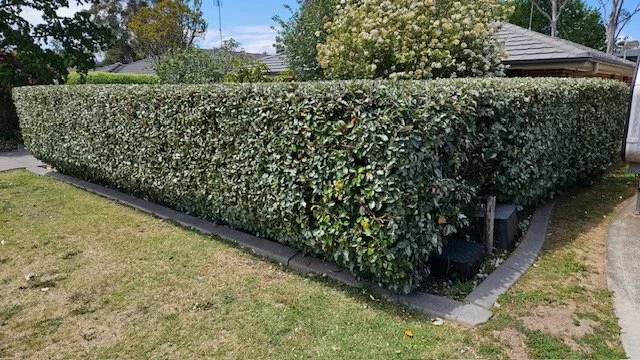There are many different types of plants that can be effectively used as hedging plants in various landscapes. There is truly something suitable for every site and garden condition. Below is a carefully curated list of the plants we think are the best options for screening and providing privacy through hedging.
BUXUS sempervirens (English), japonica (Japanese) and microphylla x microphylla (Korean) English Box is a fantastic plant choice for creating a formal hedge in your garden landscape. Traditionally, this particular type of Box has been favored for crafting elegant topiaries, adding a classic touch to any yard. On the other hand, Japanese Box tends to be a faster grower compared to its English counterpart and is generally better suited for growth in Sydney and other somewhat humid climates. In addition, Korean Box is a smaller growing variety that offers a more informal and 'shaggy' aesthetic, perfect for those looking to achieve a relaxed garden feel.
CAMELLIA sasanqua - Very versatile, this plant features dark green, glossy leaves that provide a striking appearance. It will thrive in full sun as well as in part shade, and can even adapt to full shade conditions. This characteristic makes it a fantastic choice for those tricky, variable light spots in the garden where other plants may struggle to flourish.
CITRUS spp. - Although usually planted as individual trees, citrus plants can also be utilized as an interesting and unique hedging alternative that adds both beauty and functionality to your landscape. They are best grown in full sun, ideally located in a warm and sheltered spot within your garden to ensure optimal growth and fruit production.
ELAEAGNUS - Olive green foliage that is lush and vibrant, fast-growing, and produces insignificant small but highly fragrant white flowers during the warm summer months.
FEIJOA sellowiana - The plant features striking olive green leaves and vibrant red flowers that attract pollinators. After blooming, it produces elongated fruit, adding visual contrast. This combination of foliage, flowers, and fruit offers texture and color, appealing to garden enthusiasts.
LAURUS nobilis - Bay tree is a versatile plant used in cooking for its aromatic leaves, enhancing dish flavors. It also serves as a great hedge for privacy and greenery. Prune it to about 1 metre for a compact look or let it grow up to 10 metres for drama. This adaptable plant thrives in both sunny and shaded areas, suitable for various garden settings.
PHOTINIA robusta-Glossy red/bronze growth turning green; small white spring flowers.
PHOTINIA Red Robin - Smaller growing, darker red new growth.
PITTOSPORUM - Very fast growing screening and hedging plant. Varieties include:
Green pillar - Lime green foliage 3 - 5 mtrs tall.
Silver sheen - darker green up to 6/7 mtrs.
Ivory sheen - Cream & green variegation
Golden sheen - Gold & green variegation.
Eugenioides variegatum - large green & white leaf up to 6/7 metres.
Smaller growing varieties include Golf Ball and Hole in one.
TEUCRIUM fruticans - Fast growing low hedging plant with grey foliage and a small pale violet flower.
Other plants that are also excellent choices for creating beautiful hedges include Abelia, Carpinus, Escallonia, Lavender, as well as the enchanting Magnolia varieties known as The Fairy and Scented Pearl. Additionally, you might consider including Rosemary, Spiraea, Viburnum, and Westringia in your hedging plans to add variety and interest to your landscape.


